Last year David Ratledge gave the Society a talk on recent discoveries he had made using LiDAR imaging. Of particular interest to us was this image of what he suggests is the Roman road between Coppull and Charnock Richard. It crosses a field called Row High Wood (see below) and looked quite promising so we thought we better have a look (more details here).
Category Archives: Site Visits
GPR Training Day
As mentioned in our recent Newsletter Sygma Solutions, who are based in Westhoughton, have offered the use of their Ground Penetrating Radar machines to survey local heritage sites. This includes free training, so last Monday a team of 5 (myself, Eric, Neil, Darren and Andy) went to their office in Daisy Hill for a morning’s training session. We were met by Mike Langton, who is not only their chief trainer but also teaches GPR to archaeological students at Bradford University (in fact he has appear on a number Time Team episode). He explained that the course normally took 3 days but as we were already familiar with geophysic techniques, our abridged course should be sufficient. The machines they are making available for us, use the latest technology and are capable of producing 3D images in the field. Additionally, if necessary, the data can be downloaded and they will ‘post-process’ it for us with their sophisticated software.
After lunch, with the knowledge gained, we made our way to Haigh Hall where we had previously obtained permission to carry out a demonstration of the equipment. The area selected was on the terrace between the Stables Cafe and the Hall. Mike explained that the unit is capable of ‘seeing’ up to 8 metres deep depending on ground conditions but in general 2.5 metres gives best result. After some general prospecting Mike showed us how to mark out a 10m x 10m grid and proceeded to carry out the survey (readings are taken every 5cm with scan run spacing of 50cm).
Mike explained that the unit is capable of ‘seeing’ up to 8 metres deep depending on ground conditions but in general 2.5 metres gives best result. After some general prospecting Mike showed us how to mark out a 10m x 10m grid and proceeded to carry out the survey (readings are taken every 5cm with scan run spacing of 50cm). 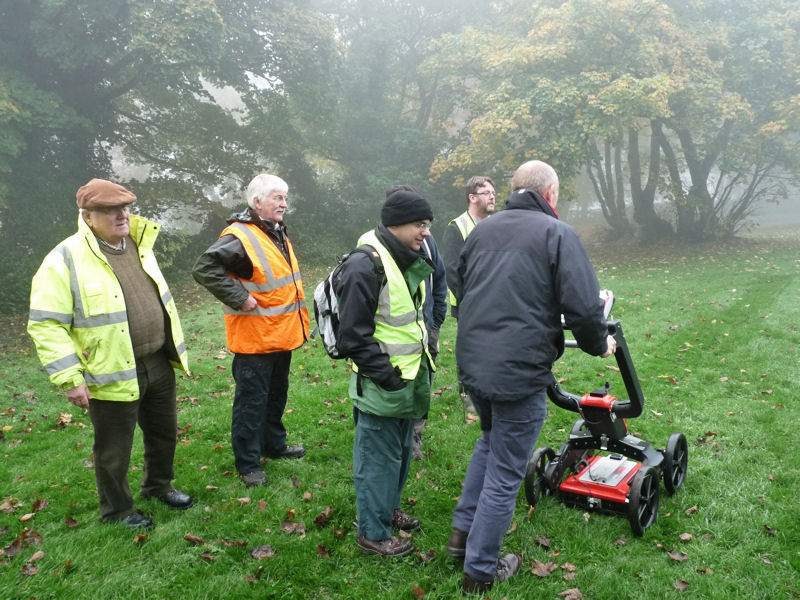 After a while he left us to it and we completed the survey (which included a second scan at 90 degrees to the first) in about an hour.
After a while he left us to it and we completed the survey (which included a second scan at 90 degrees to the first) in about an hour. The reason we had selected this particular area for the survey was that a desk-based assessment done by the GMAU a few years ago had indicated buildings here prior the building of the Stable block in the mid 19th century – and indeed the results showed structural remains at various depths from 30cms to just over a metre. The scan shown below is at 90cm, which was typical with a strong feature (maybe a wall) running at an angle to our gridlines and a structural feature running perpendicular to it.
The reason we had selected this particular area for the survey was that a desk-based assessment done by the GMAU a few years ago had indicated buildings here prior the building of the Stable block in the mid 19th century – and indeed the results showed structural remains at various depths from 30cms to just over a metre. The scan shown below is at 90cm, which was typical with a strong feature (maybe a wall) running at an angle to our gridlines and a structural feature running perpendicular to it.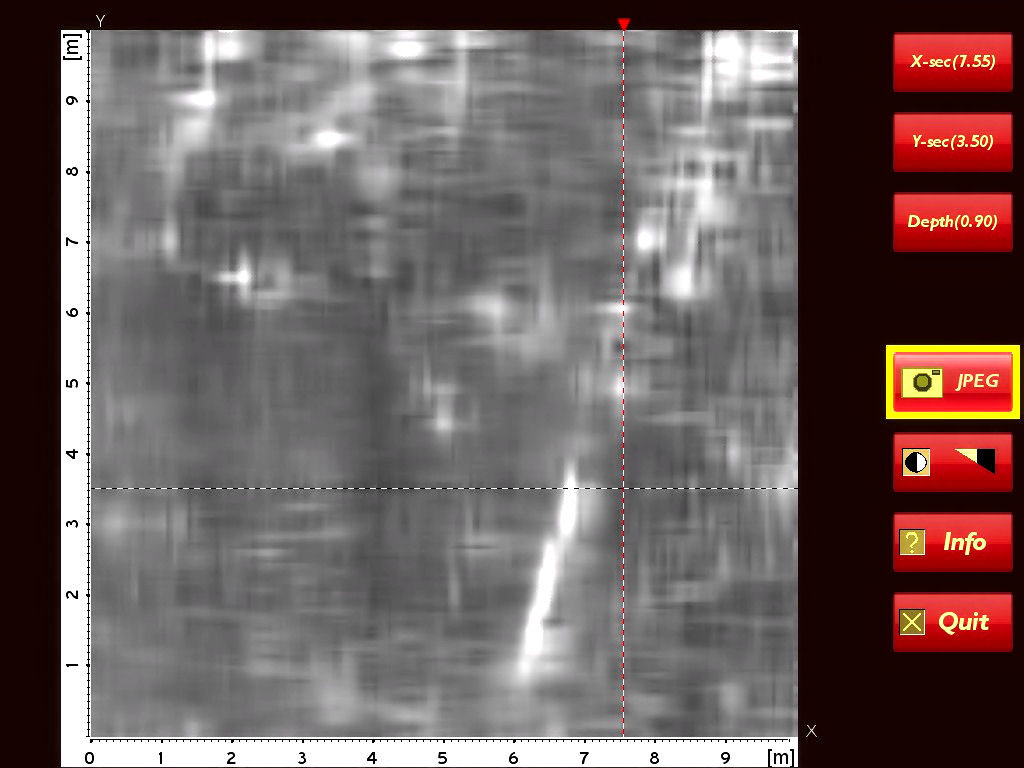
We are now quite familiar with the equipment and, given the opportunity, we would be able to complete a full survey of the area. This would give us a comprehensive picture of the archaeology in a area which maybe subject to development in the near future. We would like to thank Peter Ashcroft of Sygma Solutions for organising the day and Wigan Council for allowing us on site.
While on site we were join by Patrick and after the survey he suggested we take a look at some ruins he’d spot alongside the path leading into the plantations (maybe it was the reputed summer house shown on early paintings and engravings) A tape measure showed the remains to cover an area over 15 metres long (50 feet) with features such as stone window frames and stone box structures. On the OS map of 1893 the ruins are marked as Park Cottages – they are also shown on the 18th century estate map therefore must be of some age. The suggestion is that they would make a good subject for a future surveying project.
A tape measure showed the remains to cover an area over 15 metres long (50 feet) with features such as stone window frames and stone box structures. On the OS map of 1893 the ruins are marked as Park Cottages – they are also shown on the 18th century estate map therefore must be of some age. The suggestion is that they would make a good subject for a future surveying project.
Haigh Canal and Railway
Sunday 23rd November. A few weeks ago Trevor Boardman from the Greenheart Project contacted our Society asking about our knowledge of the Leyland Mill Iron Works (Haigh Foundry) and in particular the canal and railway that linked it to the coalfields around Whelley. I had heard of their existence but had no idea where they ran or if there was still evidence on the ground. His offer to show us the routes of these early transport links therefore, was an opportunity we couldn’t miss. So at quite short notice a field trip was quickly arranged.
The few of us who could make it met with Trevor at the Plantation Gates in Whelley. This is just south of the where the Whelley Loop line used to cross the main road to Aspull. Dismantled and made into a public footpath, this line originally opened in the late 19th century creating a by-pass from the L & Y line to the Northwest main line. Our tour started here as the construction of the line has destroyed any evidence of the canal and railway anywhere east of this point.
We weren’t long into our walk when Trevor showed us the first evidence of the canal – a ditch halfway up the side of the embankment. I must admit it wasn’t convincing but as we progressed further down the path and crossed the tarmac road leading to the hall, we found ourselves on a level metalled track. This did look like the embankment of a railway but the ditch running along side did not look particularly canal-like (it could have been just a depression caused by the embankment). However as we progressed along the track, a bank started to develop separating the railway from the ditch. The ditch was also getting wider and thus more convincing as a canal.
Rounding the next bend the canal feature seemed to take a shortcut through a cutting, the rail track however taking a wider sweep. Further on the track began to separate from the canal and started to go downwards on a gentle slope. The canal however remained level. After a short while the canal ditch ended up in a small body of water which was held back by a dam with a foot bridge over it. This was obviously the source of the water for the canal. 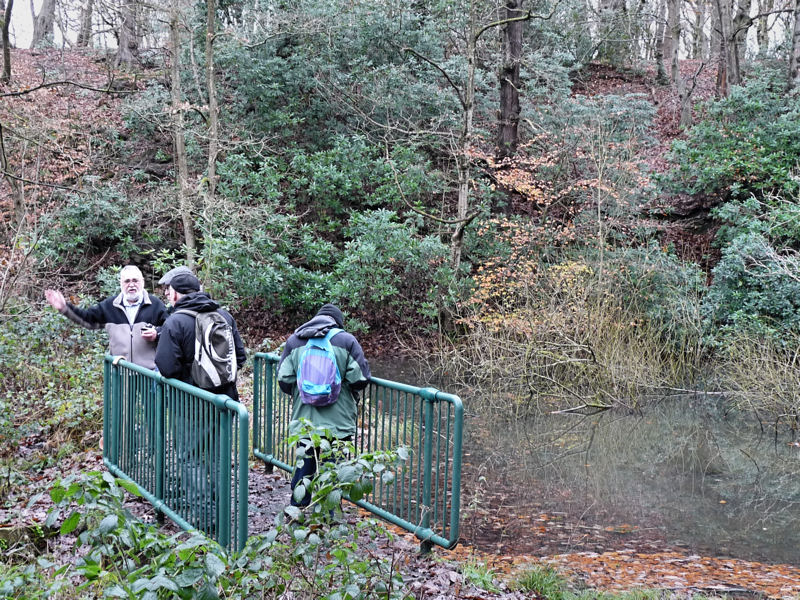 On the other side of the water the canal continued and any doubt that it was a canal was removed as it was now full of water.
On the other side of the water the canal continued and any doubt that it was a canal was removed as it was now full of water. 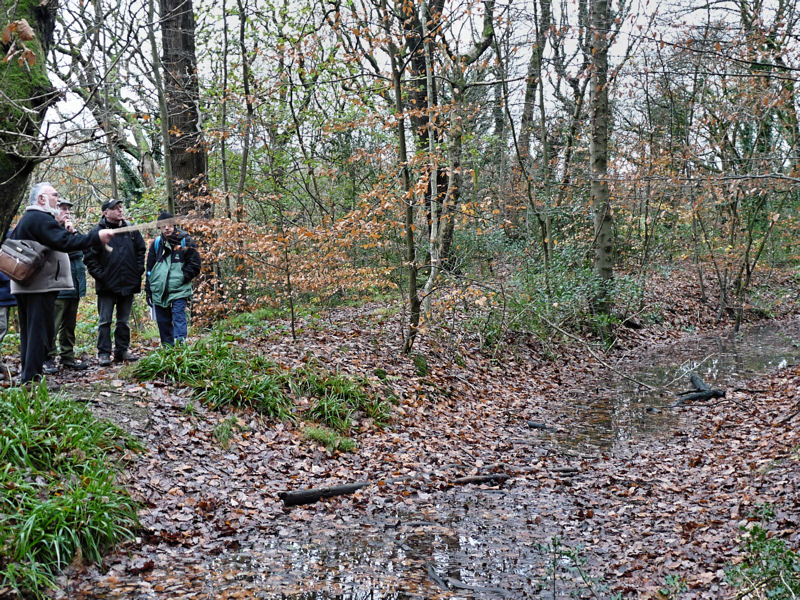
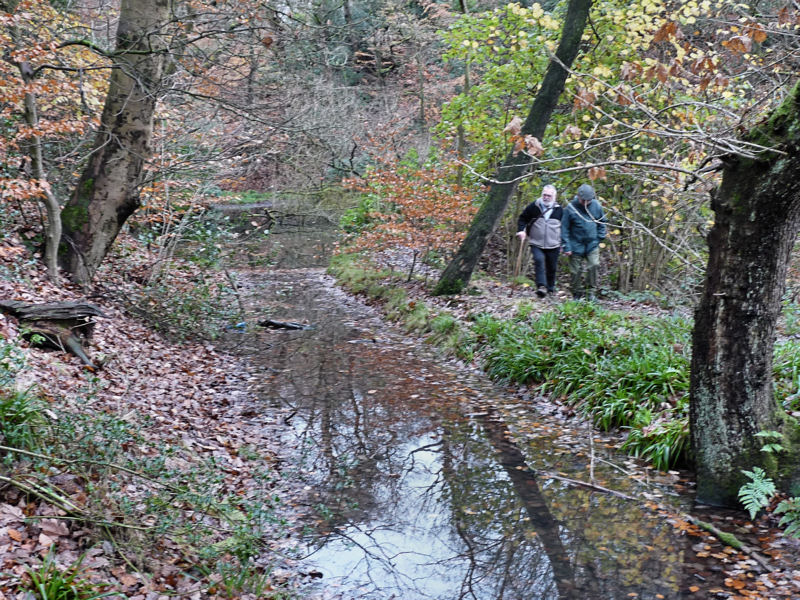 After passing a disused stone quarry, we eventually we arrived at our destination i.e. Leyland Mill which is now occupied by industrial units. Here the canal stops abruptly as a steep precipice overlooking the mill site prevents it progressing any further. Material would have to be unloaded from the barges here and lowered down to the factory site. In the distance we could see the bridge carrying Leyland Mill lane and beyond more factories some dating to the 19th century.
After passing a disused stone quarry, we eventually we arrived at our destination i.e. Leyland Mill which is now occupied by industrial units. Here the canal stops abruptly as a steep precipice overlooking the mill site prevents it progressing any further. Material would have to be unloaded from the barges here and lowered down to the factory site. In the distance we could see the bridge carrying Leyland Mill lane and beyond more factories some dating to the 19th century.  The major mill buildings from the days of the foundry no longer exist but there other buildings and workshops that have survived.
The major mill buildings from the days of the foundry no longer exist but there other buildings and workshops that have survived.
Lord Lindsay, the Earl of Balcarres, established his Iron Works here in 1788 running two blast furnaces and a cupula furnace for re-melting the scrap iron. There were also forges here and also at Brock Mill just a few hundred metres up stream. The theory is that the canal was built to supply the foundry with the quantities of coal required for the smelting and forging. At some point in time the railway line was added to replaced the canal as it was able to run into the works thus avoiding the steep precipice. Smelting ended on the site sometime before 1815 but the engineering works continued until the mid 19th century. It would become well know for producing steam engines and other machinery including the famous Laxey Wheel on the Isle of Man.
The canal and railway are fascinating rare fragments Wigan’s early industrial heritage predating the huge Kirkless Iron Works site by over 70 years. In deed when Haigh Hall was rebuilt in the mid 19th century the estate was landscaped and planted with the ubiquitous rhododendrons – thus sweeping away much of the eyesores left by the many years of intensive coal mining. Studying the 1849 6 inch OS map shows that, apart from the small body of water, there is no sign of the canal or the railway. We are very lucky therefore that evidence for them still survives.
A good project for the Society would be to survey the route properly producing an accurate map (a surveyed was carried out by Donald Anderson when the features were first identified. However this was a height survey to establish that the canal was in deed level and the inclination for the railway wasn’t to great. If we could get permission to dig we could also answer other questions such as how wide the canal was and whether it actually did predate the railway. It would be useful to confirm the date of the canal (mining has been carried out on this estate since at least the 16th century) but proving its age might prove quite difficult.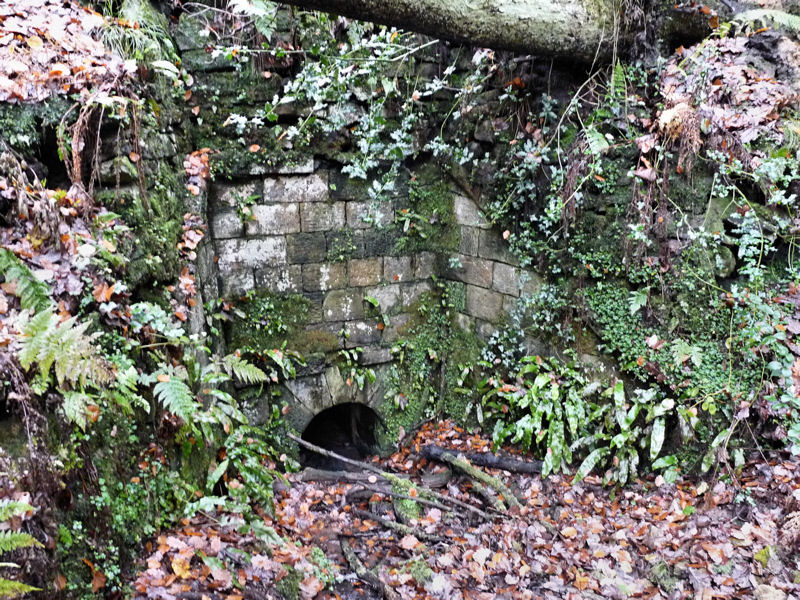 Culvert running under the substantial railway embankment
Culvert running under the substantial railway embankment
Summer Trip
Worries about the weather and traffic problems turned out to be unfounded as our trip to Sandal Castle near Wakefield and Castleshaw Roman Fort went off without a hitch – more details here…
Summer Trip
What a great day we had on Sunday. Our first site, the Iron Age Hill Fort at Bodfari in North Wales meant a steep climb but it was well worth it. We were met by Gary Lock, emeritus Professor of Archaeology at Oxford University, who has been excavating here for a few seasons now…. more details here
Rectory Return
This was our first visit to this site since last September. Surprisingly the trench we left open has survived quite well and it didn’t take us long to clear it of mud and rotting leaves (we didn’t even have to pump the water out). More detail in our Rectory Project Archive –Area 1).
Pingot Return
Sunday 19th May. Eventually the weather cleared enough for us to make a return visit to the Pingot Valley (myself, Mary, Mark and Andy). Eric had previously managed to make contact with the Winstanley Estate warden who said we were OK to work on the site. He agreed we could survey and record features but if we wanted to excavate we would need to get permission from Tim Banks who is still the land owner. For more details of our visit, select the Pingot Valley tab.
Kirkless Site Visit
Last Sunday a team of 4 from our Society began to survey this site which lies to east of the Leeds and Liverpool Canal in Higher Ince. We have been asked to get involved with this project by Liz Vango-Smith, of the Wild Life Trust. The intention is to see if we can identify and record features of the old iron works that may have have survived recent landscaping – for more details see the Kirkless tab.
Pingot Valley Site Visit
Our attention was drawn to this site last year by Derek Winstanley who now lives in the US. He had noticed on a recent visit that there were remains of the old lime kiln marked on the 6 inch OS map of 1849. I’d looked at the site last year but other commitments at the time meant that it’s only now that perhaps we’re able to spend some time on it (see new ‘Pingot Valley‘ tab for details).
Site at Glazebury
On a misty morning Last Sunday Andy Wilock and I visited a site on the edge of Chat Moss near Glazebury. We were invited there by Marlene Nolan of Culcheth History Society who had spotted the site while field walking. It seemed to her to be some kind of defensive earth work lying at a strategic point on the banks of the River Glaze. You may be wondering why she asked us to look at this site so far away from Wigan – but, surprising as it may seem, quite a lot of Chat Moss does lie within the Wigan Metro Borough.
The site is located north of Moss Lane which branches off Hey Shoot Lane about 200m east of the River Glaze near the Raven Pub. It’s surrounded on three sides by a large bank with a ditch on the south side. The interior is flooded up to a point where a cut in the bank allows the water to escape. 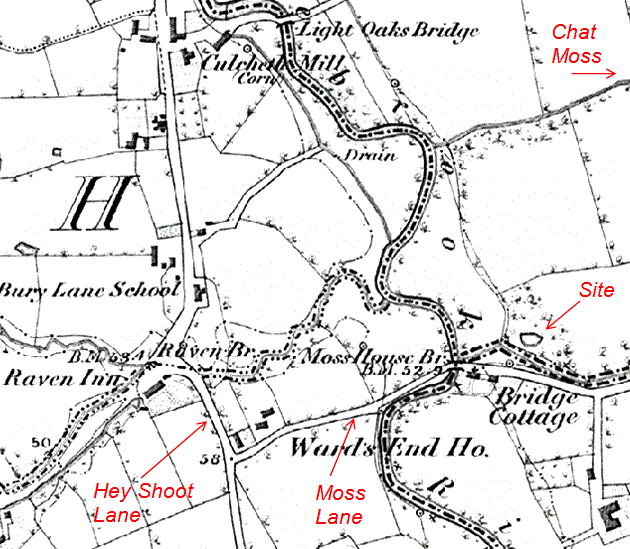
Judging from the maturity of the trees we perceive the site must be at least a 200 or 300 years old but a quick check on the 6″ OS map of 1846 gives no indication of its origin. The history of the area suggests a possible Civil War connection as apparently there was a large skirmish in the vicinity. Another slight possibility is that it could be much older as an Iron Age site had been discovered a few years ago only about one mile south of this one.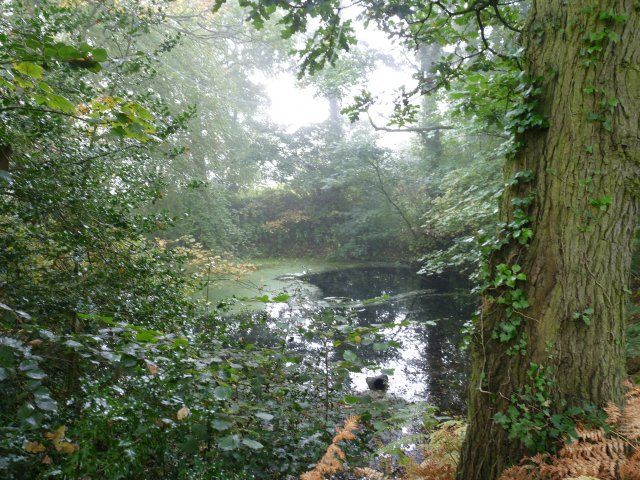
More likely however it’s the product of some pre-Victorian industrial activity such as sand, stone or clay extraction – a trench across the embankment may give the answer but whether we’d get permission is another thing.
